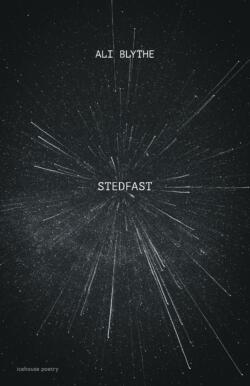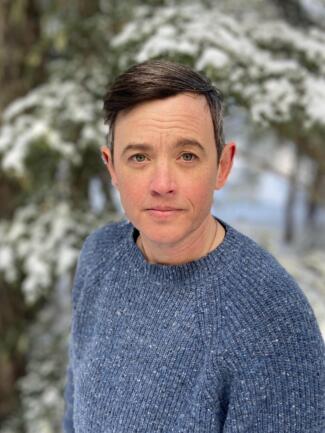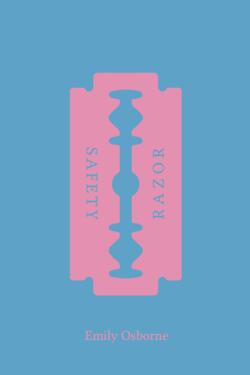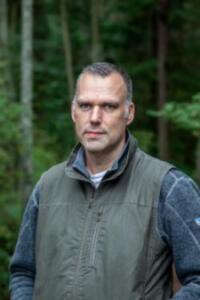1924 The lived, the eternal, the ancient
Stedfast
by Ali Blythe
Fredricton, NB: Goose Lane/ Icehouse Poetry, 2023
$19.95 / 9781773103051
Safety Razor
by Emily Osborne
Guelph, ON: Gordon Hill Press, 2023
$20.00 / 9781774220856
Reviewed by Joe Enns
*
Two BC poets use different poetic techniques to connect their lived experience to the ancient and eternal.
 Stedfast, Ali Blythe’s third poetry collection, is a focused yet complex constellation of poems in which the poet searches for the self and the divine while exploring the theme of love. Blythe claims, “…to write / any love poem // you must first invent / the poet who will write it.” This notion of self-composition or revelation through art weaves together aspects of music, the stage, mythology, and astronomy, all within questions about relationships.
Stedfast, Ali Blythe’s third poetry collection, is a focused yet complex constellation of poems in which the poet searches for the self and the divine while exploring the theme of love. Blythe claims, “…to write / any love poem // you must first invent / the poet who will write it.” This notion of self-composition or revelation through art weaves together aspects of music, the stage, mythology, and astronomy, all within questions about relationships.
Victoria, BC-based Blythe creates or re-creates himself in an iterative process through language. He writes that “after a time alone, the coyotes / were conjuring each other,” the idea being that poetry, like howling at the stars, can be a lonely process where the poet “…tries to compose a self / while God listens.” But add another level to that, “failing to illuminate ourselves, / we seize what shines…” This mosaic of deep themes runs concisely throughout each poem of the collection.

The twenty-eight poems derive their names from lines, or partial lines, in John Keats’ 1838 poem “Last Sonnet,” which creates an interesting parallel, connecting concepts of the eternal and mortality with love. At first, I wondered about the repetitiveness of the form (every poem is in couplets) but by the end I appreciated the consistency and simplicity, which was appropriate to the central premises of the book. Blythe seems to comment on this: “each new day is cut / from the key of the last,” and “write it out again. / And so on down the page of us.” The idea of the page as a stage or a bedsheet dotted by two revolving stars or asterisks or lines as in the couplets (“Aren’t we but two asterisks / atop white sheets?”) works brilliantly throughout and is introduced at the front of the book without words at all, just two offset asterisks near the top of the page.
While Stedfast relies more on abstract ideas and resists specific imagery, Blythe’s smooth word choices and subtle use of sound make the poems accessible, while also full of realization. For example, the opening lines of the poem “Or else swoon” (which is a lightning rod of a poem that seems to bring together everything going on in this book) reads, “A winter dawn / we swan // in the follow spot / of our fabled stage.” Blythe’s assonance here to emphasize the importance of these images as the nucleus of the book’s themes is so powerful because this literary device is not overused in the rest of the book.
Blythe builds a tight yet layered work of art in Stedfast that conveys a tone of loneliness and search for connection with oneself, a companion, or the eternal (“…just divine // self-revelation / between best friends.”). Just like the two asterisks on a blank page, “two figures continue / their delicate revolutions,” or an unsteady star, Stedfast is a slow burn that leaves a mark.
 Safety Razor, Bowen Islander Emily Osborne’s debut book of poetry, is a dense journey through images and anecdotes, each line a full use of sound and rhythm. The collection of poems is split in three parts that seem to cover different eras or aspects of the speaker’s lived experience.
Safety Razor, Bowen Islander Emily Osborne’s debut book of poetry, is a dense journey through images and anecdotes, each line a full use of sound and rhythm. The collection of poems is split in three parts that seem to cover different eras or aspects of the speaker’s lived experience.
Overall, the book reads as though it’s a collection of poems Osborne wrote over a long period of time and then arranged afterwards according to emergent themes as a sort of journal, as opposed to a pre-planned work with a unified central idea (in the vein of Blythe’s book). This approach is apparent in the change of tone between the three parts. Part One, titled “First Cuts,” is a reminiscence of childhood, each line packed with poetic devices that add layers of complexity and meaning. This writing style has benefits and disadvantages. While the unconventional word choices and phrasing adds a deeper significance to the imagery (“of window while hailstones pelt, clouds cutting / their diamond lumps. Mum finds me a bunny”), the reading becomes much slower and cryptic or inaccessible at times.
Part Two, titled “Bare Bones” is when Osborne really hits her stride. “Bare Bones” summons strong imagery about the interaction between the ancient abiotic (landscape and climate), the natural world, language, and the inner landscape (“but now we carve grave and caret on separate / word trees. I can’t read your DNA or lips.”). Each poem leaves an impression of traumatized bodies—human and nonhuman—with life etched into their bones. Some of these dynamic themes carry over into Part Three (“Flesh Meets”), for example, the poem “First Flood,” and the imagery of this motif would make a great foundation for a book on its own.

Osborne includes several translations from Old Norse-Icelandic skaldic, which fit well in “Bare Bones.” The translation in the poem “Rune carving” embodies the ideas put forth in the rest of the part: “for I carve runes on the mead-cups, / sealing word-play with bright blood.” The variety of form between poems is refreshing. As well as translation, Osborne includes ekphrasis, Haiku, quatrains, and free verse.
I admit that the title of this book, Safety Razor, puzzled me for a while. There’s a theme of carving and cutting in Part Two, but the idea of safety or risk threw me off. I googled the term and when I read the Wikipedia definition “a protective device positioned between the edge of the blade and the skin,” I got the impression of these works or language acting as a buffer between the speaker and memory (“…If the radio wheezed safety, / it’s blurry”).
Safety Razor evokes a strong paradigm of imagery with layers of complexity built through interesting word choice, rhythm, and assonance: “My mind stalls in a carnal garage, where lost / scraps can be collared. A body in a boneyard, shut too hard.” Osborne succeeds in re-creating her lived experience through language with gut punches of honesty (“remember the sharp gun-metal / of an adult’s tongue on mine. / Some tastes you can’t categorize”) and connects these themes to the ancient and eternal (“Art opens from wounds as far back / as anyone dates it. Death lays down / a flat canvas for carving”). While Osborne’s poetry can be difficult to stumble through superficially at times, rereading is always rewarded.
*

Joe Enns is a Canadian writer, painter, and fisheries biologist on Vancouver Island. His writing has appeared in The Dalhousie Review, FreeFall, The Fiddlehead, GUSTS, Portal Magazine, and is forthcoming in The Malahat Review. His fiction was shortlisted in FreeFall’s 2020 Prose and Poetry Contest. Joe has a BA in Creative Writing and a BSc in Ecological Restoration. [Editor’s note: Joe recently reviewed Will Goede and Evelyn Lau for BCR.]
*
The British Columbia Review
Interim Editors, 2023-24: Trevor Marc Hughes (non-fiction), Brett Josef Grubisic (fiction)
Publisher: Richard Mackie
Formerly The Ormsby Review, The British Columbia Review is an on-line book review and journal service for BC writers and readers. The Advisory Board now consists of Jean Barman, Wade Davis, Robin Fisher, Barry Gough, Hugh Johnston, Kathy Mezei, Patricia Roy, Maria Tippett, and Graeme Wynn. Provincial Government Patron (since September 2018): Creative BC. Honorary Patron: Yosef Wosk. Scholarly Patron: SFU Graduate Liberal Studies. The British Columbia Review was founded in 2016 by Richard Mackie and Alan Twigg.
“Only connect.” – E.M. Forster
4 comments on “1924 The lived, the eternal, the ancient”